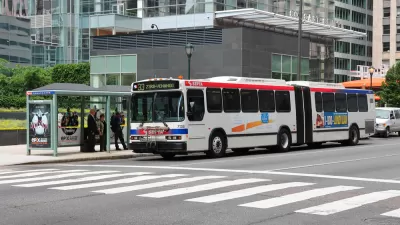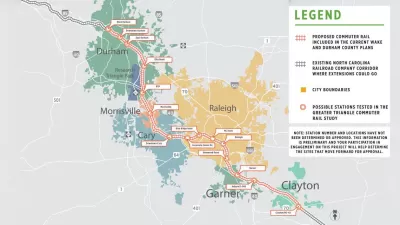The final infrastructure deal cutting by more than half the transit funding proposed in the American Jobs Plan.

As Congress finalized its infrastructure deal, writes Jeff Davis, the funding allocated to public transit shrank "from $85 billion (really $110 billion) in President Biden’s American Jobs Plan, down to $48.5 billion in the June bipartisan infrastructure 'framework,' to $39.2 billion in the final bipartisan infrastructure deal."
In the June 24 BIF, "President Biden and his team had signed off on a framework that reduced the total above-baseline funding for roads, bridges, and major projects by 31 percent ($49 billion) from the combined total in the original American Jobs Plan. But the White House had also endorsed a framework that reduced above-baseline funding for public transit from $110 billion (including the electric transit buses) to $48.5 billion, which was a 56 percent reduction from the original request."
Then, transit funding was slashed again by $4.4 billion. "This time the reduction came entirely from the general fund advance appropriations for the Federal Transit Administration, reducing that amount of money from $24.35 billion to $20.00 billion, and reducing the total above-baseline mass transit funding provided by the bill down to $39.2 billion."
"Transit advocates are looking to reopen the bipartisan bill by getting additional funding for mass transit as part of the budget reconciliation bill that will move through Congress in September and October." But if that happens, Davis writes, "members of the bipartisan Senate negotiating team might feel obligated to reopen the other parts of the bill that were negotiated in exchange for the lowered transit funding."
FULL STORY: How Transit Got Traded Away in the Bipartisan Infrastructure Deal

Alabama: Trump Terminates Settlements for Black Communities Harmed By Raw Sewage
Trump deemed the landmark civil rights agreement “illegal DEI and environmental justice policy.”

Planetizen Federal Action Tracker
A weekly monitor of how Trump’s orders and actions are impacting planners and planning in America.

Why Should We Subsidize Public Transportation?
Many public transit agencies face financial stress due to rising costs, declining fare revenue, and declining subsidies. Transit advocates must provide a strong business case for increasing public transit funding.

Understanding Road Diets
An explainer from Momentum highlights the advantages of reducing vehicle lanes in favor of more bike, transit, and pedestrian infrastructure.

New California Law Regulates Warehouse Pollution
A new law tightens building and emissions regulations for large distribution warehouses to mitigate air pollution and traffic in surrounding communities.

Phoenix Announces Opening Date for Light Rail Extension
The South Central extension will connect South Phoenix to downtown and other major hubs starting on June 7.
Urban Design for Planners 1: Software Tools
This six-course series explores essential urban design concepts using open source software and equips planners with the tools they need to participate fully in the urban design process.
Planning for Universal Design
Learn the tools for implementing Universal Design in planning regulations.
Caltrans
Smith Gee Studio
Institute for Housing and Urban Development Studies (IHS)
City of Grandview
Harvard GSD Executive Education
Toledo-Lucas County Plan Commissions
Salt Lake City
NYU Wagner Graduate School of Public Service





























